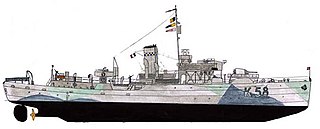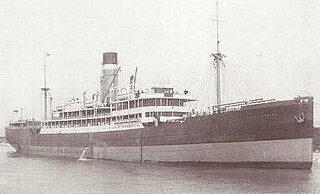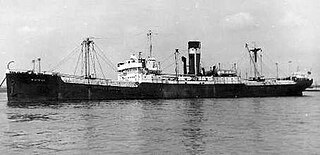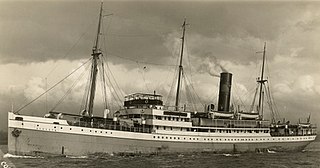
Aconit was one of the nine Flower-class corvettes lent by the Royal Navy to the Free French Naval Forces. During World War II, she escorted 116 convoys, spending 728 days at sea. She was awarded the Croix de la Libération and the Croix de Guerre 1939–1945, and was cited by the British Admiralty. Following the war she was used as whaling ship for three different companies from 1947 to 1964.
Vorwärts was a wolfpack of German U-boats that operated from 25 August to 26 September 1942, in the Battle of the Atlantic during World War II. They attacked several convoys, principally Convoy ON 127, sailing from Liverpool to New York, and sank fifteen ships for a total of 79,331 gross register tons (GRT), and damaged nine (81,141 GRT).

SS Clearton was a 5,219 gross register tons (GRT) British cargo steamship. She was launched on 29 July and completed in September 1919 by Richardson, Duck and Company, Stockton-on-Tees for the shipping firm of R. Chapman & Son, Newcastle-upon-Tyne. Her homeport was Newcastle-upon-Tyne.
MV Atheltemplar was a motor tanker built by Lithgows, Port Glasgow. She was launched on 15 April 1930, registered in Liverpool and operated by the United Molasses Co Ltd of London. She was transferred to Athel Lines on 1 January 1940.
SS River Afton was a steam merchant built in 1935 by Lithgows, of Port Glasgow, Scotland and homeported in Glasgow. She was operated by Campbell Brothers & Co, Newcastle-upon-Tyne. She was named after the River Afton in Ayrshire, Scotland.

SS City of Venice was an intermediate ocean liner that was launched in 1924 in Northern Ireland for Ellerman Lines. In the Second World War she was a troop ship. In 1943 a U-boat sank her in the Mediterranean, killing 22 of the crew and troops aboard.
HMS Marigold was a Flower-class corvette of the Royal Navy. She was launched on 4 September 1940 and was sunk by an Italian air-dropped torpedo on 9 December 1942.

SS Blairspey was a steam cargo ship that was built in Scotland in 1929 and served in the Battle of the Atlantic in the Second World War. In 1940 she survived being part of Convoy SC 7 and managed to reach port, despite being hit by at least three torpedoes from two different U-boats. The ship was rebuilt with a new bow and renamed Empire Spey 1942. Her original name was restored in 1946. She was renamed Evandros 1961 and scrapped in Italy in 1967.

SS Fiscus was a UK cargo steamship that was built in 1928, served in the Second World War and was sunk by a U-boat in 1940.

SS Uhenfels was a German-built heavy-lift ship that was launched in 1931 for DDG Hansa. She was captured by the Royal Navy in 1939, two months after the start of the Second World War. The UK Ministry of Shipping renamed her Empire Ability and contracted Elder Dempster Lines to operate her. In 1941 a German U-boat sank her by torpedo.
Empire Barracuda was a 4,972 GRT cargo ship which was built in 1918 for the United States Shipping Board (USSB) as Sacandaga. She was sold to American Diamond Lines in 1932 and renamed Black Heron. In 1941 she passed to the Ministry of War Transport (MoWT) and was renamed Empire Barracuda. She was torpedoed on 15 December 1942 and sunk by U-77.
Empire Bede was a 6,959 GRT cargo ship which was built by G M Harland & Wolff Ltd, Glasgow in 1942 for the Ministry of War Transport (MoWT). She had a short career, being damaged by a torpedo and then sunk by gunfire on 18 August 1942.
SS City of Oxford was a steam merchant ship built in 1926 by Swan, Hunter & Wigham Richardson Ltd., in Newcastle-upon-Tyne and sunk by a German submarine on 15 June 1942. Measuring 2,759 gross register tons she entered service with the Ellerman and Papayanni subsidiary of Ellerman Lines, and served during the Second World War.

SS Shuntien was a 3,059 GRT coastal passenger and cargo liner of the British-owned The China Navigation Company Ltd (CNC). She was built in Hong Kong in 1934 and sunk by enemy action in the Mediterranean Sea with great loss of life in 1941. A Royal Navy corvette rescued most of Shuntien's survivors, but a few hours later the corvette too was sunk and no-one survived.
SS Creekirk was a cargo steamship that was built in Scotland in 1912 and sunk with all hands by a German submarine in 1940. At her launch in 1912 she was named SS Mariston. In her 28-year career she was renamed SS Milcovul in 1913, SS Hyphaestos in 1933 and SS Creekirk in 1938.
SS Yoma was a British passenger liner that served as a troop ship in the Second World War. She was built in Scotland in 1928, and from then until 1940 Yoma ran a regular route between Glasgow in Scotland and Rangoon in Burma via Liverpool, Palma, Marseille and Egypt. She became a troop ship in 1941 and was sunk with great loss of life in the Mediterranean in 1943.
SS Umona was a British cargo liner. She was built at Sunderland on the River Wear in 1910, survived the First World War and was sunk by enemy action off Sierra Leone, West Africa in 1941.

SS Avoceta was a British steam passenger liner. She was built in Dundee in 1923 and was sunk by enemy action in the North Atlantic in 1941. She belonged to Yeoward Line, which carried passengers and fruit between Liverpool, Lisbon, Madeira and the Canary Islands.

SS Fuso Maru was a Japanese ocean liner that was torpedoed by the United States Navy submarine USS Steelhead (SS-280) in the South China Sea 280 nautical miles (520 km) northwest of Cape Mayraira, Luzon, the Philippines, at, while she was travelling in Convoy MI-11 from Moji, Japan, to Miri, Borneo.
SS Hartlebury was a cargo steamship that was launched in Scotland in 1934 for J&C Harrison Ltd. A U-boat sank her in the Barents Sea in 1942 when Hartlebury was a member of the Arctic convoy Convoy PQ 17.









